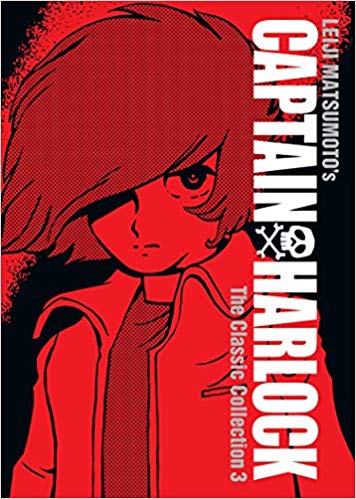By Leiji Matsumoto. Released in Japan as “Uchuu Kaizoku Captain Harlock” by Akita Shoten, serialized in the magazine Play Comic. Released in North America by Seven Seas. Translated by Zack Davisson. Adapted by Snati Whitesides.
In many respects this is Daiba’s story more than Harlock’s, and we’ve been following his journey and not really going back to show how Harlock got started, got the crew together, etc. That said, just because we started with Daiba doesn’t mean we get a satisfying ending for him – or anyone. A lot of Matsumoto series, I’ve found, tend to best be described as “a cutout of a larger, more epic tale”, even when they’re being epic tales themselves. And so this volume wraps up with not much having changed, except that we’ve possibly found the Mazon are more similar to humanity than anyone expected – except, of course, the reader. The Arcadia, with its main cast all intact, set sail to further adventures and battles, which we, as a reader will not see, because Matsumoto wrapped up the manga at this point, probably so he could concentrate more on Galaxy Express 999.
A lot of the back half of this volume is concerned with the life and death of Tochiro, who frequently appears posthumously in the Harlockverse (he was in Queen Emeraldas as well) but rarely shows up in the flesh. His death looms over everyone, and is handled with such reverence and dignity that when a rogue Mazon tries to attack Arcadia while they’re at his gravesite, the Queen literally throws her off the ship, where she falls to her death, because let’s face it, these are pirate ships more than spaceships. It’s a bit ridiculous, but fits with the overall mood of the book, which is brooding, somber, and oh so serious. Aside from the occasional stab at humor, such as everyone’s collections falling over in a battle, or Kei getting fall down drunk at one point, the laughs of the last two books are mostly gone. (There is a short Harlock/Emeraldas story added after the main events here, which is meant to show them as almost Rule 63 versions of each other. I didn’t enjoy it much, but it DOES have humor.)
As for Daiba, well, he’s trying hard to grow and learn everything as fast as possible, and that’s not going very well, though he is rather clever. Harlock seems to be grooming him as a sort of heir at times. He also helps to discover the Mazon’s involvement with the Ancient Pyramids, as the Wagnerian myth takes a slight detour and also shows off the Mazon as sort of dandelion spores that will gradually infect everything in the galaxy. Not the world’s most original plot, but that’s fine, as you’re reading a story about space pirates, so originality is not why you’re here. The dialogue continues to be ripe, even with the seriousness, and I think it may actually work even better if you read it aloud in a stentorian voice, sort of like William Daniels as Captain Harlock.
The modern-day reboot of the series, Dimensional Voyage, is still going strong, and adding a bit more depth and characterization that isn’t in this original. But if you want the definitive mood for Harlock, it’s hard to beat this three-volume set, which is dramatic and stentorian to the last. A classic slice of manga history.





